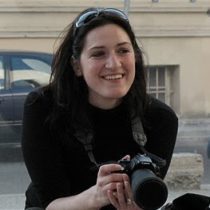Landscape Architecture for Landscape Architects › Forums › PORTFOLIO & RESUME › Displaying my masters thesis project in my portfolio
- This topic has 1 reply, 5 voices, and was last updated 12 years, 2 months ago by
 ALEX P.
ALEX P.
-
AuthorPosts
-
May 16, 2012 at 8:59 pm #157505
 Roland BeinertParticipant
Roland BeinertParticipantI’m looking for advice on how to display my thesis project in my portfolio. Should I write about the research I did or just display some of the GIS maps I produced? Will potential employers be interested in knowing that I researched urban ecology or how I produced the maps? Should I try to condense the entire project down to one sheet or put in two or three that show what I did and why? Will employers be interested in the thinking behind the project or will they just be interested in the fact that I can use GIS?
May 17, 2012 at 2:51 am #157515 ALEX PParticipant
ALEX PParticipantStep 1: dont use papyrus / myriad pro / arial
Step 2: condense, condense condense. all gis maps look alike, so pick the coolest ones/ the ones that best represent your thesis.
Step 3: limit the text, no one will read more than the title, so dont even waste your time. give um a taste, then if you get an interview, go into detail about the thesis research
Step 4: dont overlap any images / maps. set them up in a clean and simple grid.
Step 5: no drop shadows
Step 6 (should be 0): make your portfolio in indesign. the smaller your file, the happier the future employer.
Step 7: dump all the cute/cool effects, just keep it uber simple. no trendy colours, shapes, et al. Trust me you will look back and think, why did i use these ugly green rectangles as ‘title bars’ white, always looks good. just skim through most of the ‘portfolios’ on here as examples of what-not-to-do.
Step 8: save as a pdf
Step 9: enjoy your well laid out portfolio (in helvetica neue).
Step 10: employment
May 17, 2012 at 1:02 pm #157514 Karolina BoberParticipant
Karolina BoberParticipanthehe, great advise!
Now, after few years working on my own I’m going to search for a job.
Preparing portfolio gives me a stomachache;)
May 17, 2012 at 2:04 pm #157513 Tosh KParticipant
Tosh KParticipantA lot of this depends on whether you are mailing this off or bringing it in in-person and the nature of the work you are applying for.
1. For academic/research positions do include text that explains why/what/how and enough images to outline the research process.
2. Some firms may be more interested in what you can produce while others will be more interested in how you pursue research.
3. 1 sheet for a thesis can’t be enough for a portfolio, though maybe for a work sample; any in-depth studio project easily eats up 2 spreads (diagrams showing the topics, design diagrams, research data visualization, etc) in a full portfolio. Too long and it’s boring, but not enough and one is led to wonder how much was actually produced.
4. The thinking is important to some, others may only be important in how fast you can operate in a GIS software – the former presumably make for a more engaging work environment.
5. san serif fonts are easier to read; some people love/hate particular fonts; unless you really care stay neutral in your choices.
6. it’s worth going through some portfolios online (the archinect site has nice links to architect’s portfolios worth looking into).
7. take time and care in layout and organization of images – designers like to think of themselves as graphic designers, cater to it.
good louck, I kept my thesis as a separate book, full sized copy had all my research in it (80 pages) and was given to critical practices with principals that taught; the design only version had 15~20 pgs and was mailed with my short portfolio (5~6 projects + sketches/photography/collages). Full portfolio w/o thesis is about 25~30 pages, just long enough for a 30 min presentation interview. Thesis was usually another 20~30 minutes, the full version was used to show the ability to carry through project research to presentation.
May 17, 2012 at 9:41 pm #157512 Lana MerrillParticipant
Lana MerrillParticipantAgree and disagree with these steps. Different employers look at things differently.
AMEN to step 1, but don’t feel like you have to use helvetica neue (it’s great for text/descriptions, but you can make the title a snazzier font)
?? — Step 3: My way of going about things is to include text (don’t freak out! I’m not implying you put a 10 page paper on one sheet). One or two simple paragraphs don’t hurt, and they help explain maps and graphics that require an actual description. I aim for size 10 font so it doesn’t overwhelm the page. Remember, you’re trying to get an interview, so you want whoever is reviewing your portfolio to know what they’re looking at.
I agree with 4-7 completely.
As far as step 8 – problem is, some things can be too boring. If you want to include a little spunk, throw it on a page that introduces the project or section of the project (concept/analysis/implementation). I would stray away from using any sass on pages that contains your work. I think of colors and graphics as a way for your brain to get excited to turn the page. Don’t go bananas though. I generally aim for two colors (red, light red or purple, light purple), black, and one shade of gray. >> Check out the Krause’s “Color Index” (You don’t have to buy it, go to Barnes and Nobles and copy the CMYK/RGB numbers of ones you think you might use)
—As far as maps/writing, etc… Here’s my advice from my experience from classmates, employers, future employers, and professors. Graphics sell. You can prove the rest of your knowledge in an interview and resume. Being in this field, I know you are creative enough to invent a way to translate your theories and findings into graphic representations (i.e. charts, matrices, etc.). Hop on the graphic design train and have fun with it. Analyses and maps are the easiest way for someone to instantaneously understand what you’re talking about so keep it simple and remember to include at least one pop of color.
One last note — as far as the number of pages, make it as many as you feel necessary. A part of employer’s evaluations is how well you can edit yourself. Make it 30 pages the first time around, then edit your work keeping in mind a general hierarchy you wish to convey.
Good luck 🙂
May 17, 2012 at 10:11 pm #157511 Roland BeinertParticipant
Roland BeinertParticipantHow about Times New Roman? Is that over-used as well?
May 17, 2012 at 10:20 pm #157510 Roland BeinertParticipant
Roland BeinertParticipantTake a look at the jpeg. I put this together this morning. I had to produce something quickly, because there was a firm that had already requested my portfolio. Hopefully the text boxes aren’t overwhelming. I used Times New Roman text. Not sure whether Alex hates that as well. I can always revise this, of course. I need to revise the rest of my portfolio, anyway.
May 18, 2012 at 5:07 am #157509 ALEX PParticipant
ALEX PParticipant*PLEASE NOTE THE FOLLOWING IS JUST AN OPINION
hate is a strong word reserved solely for papyrus and bad design. (not an opinion)
I think you may want to have a bit more hierarchy, and lose the colour boxes. Your maps are portrait, so i would still persuade you to use portrait layout. Also, no offense, but it feels a bit like a powerpoint presentation. maybe its the microsofty outlines. also, the awkard center spacing really makes the content seem weird. left justified seems like the most releveant sort of justification.
try using helvetica (or arial if using a pc) for the heading. (did i just say that?)
there is also a lack of consistency with in your maps, sometimes the title is within the wierd boxes, sometimes its not. the same thing goes for the scales THIS IS YOUR TICKET INTO A FIRM, it needs to be perfect! little things can send a very strong message. is butter the right message for these maps? probably not!
in regards to the languaged used, it seems very elementery (maybe thats a good thing?) starting each paragraph with “in this map” seems a little um.. you need to concisly articulated each subtext. hence me saying dont use text, this is the prime reason. Just say “combination of x y and z” or “conservation areas, trails, et al” Im sure you get my point.
as it stands now, the maps which im assuming you did a lot of work on, get lost in a sea of buttery text. Nothing is lined up, nothing is consistent and your eye has no where to go / understanding of what to look at.
i think with some (lots) work, you can wrangle this into something you are proud of, and most importantly confident about. that is really the key.
Helpful hints:
1. simplfy this page (see my markups)
2. line things up
3. heirarchy of text (headings/subtext)
4. remove the butter boxes/ weird exterior box – screams powerpoint!
5. re-do the maps so they are all consistent (scales and titles in the same spot)
6. think about flow (what do the following/previous pages look like?)
7. no hyp-hen-ation!!!!!!!!!!!
8. use guides and grids – they are your friends
9. reduce file size.. that pages is massive! my entire portfolio is 1.5 mb. !
10. dont throw things together, its sloppy.
im sure some people on here will tell you that what you have is fine and to not listen to me. However through all my opinions i believe that i have some valid points. keep us updated roland.
May 18, 2012 at 1:25 pm #157508 Lana MerrillParticipant
Lana MerrillParticipantYour maps are great and will definitely serve you well. And it’s awesome you’re getting feedback on this site (I kind of wish I would’ve done that sooner….. :-D)
1. The more borders, the more constricted one feels looking at the portfolio – drop them all together (even your maps). This will help create a cohesive, fluid look overall.
2. I would stray away from Times New Roman as it can read…well… a little boring and, in my opinion, has a “thrown together” look to it. It is meant for papers, not portfolios — try Gill Sans if your PC based.
3. These maps would look even better if they each had their own page in portrait form. Portrait generally is hard to work out, but if it’s done right, looks awesome. Blow up those maps on each page and add relevant pictures that depict what you intend your analysis to affect (i.e. storm water conservation may have pictures of landscapes where water is obviously managed well through systems you intend to use; food production would depict community gardens or residential farms that you feel would suit the indicated areas best). These pictures will help give someone quickly flipping through your portfolio a better idea of the intentions of your analysis.
—P.S. Don’t abbreviate things in your map – i.e. final_rec — I’m assuming that means final recommendations? Be specific.
4. Your descriptions shouldn’t state what you’re obviously showing in your maps. Instead, write one or two sentences of how the maps/analysis will influence the next step in your thesis. This adds fluidity and gives you the opportunity to get someone interested.
Great start, don’t be afraid to post your revised version!
May 18, 2012 at 5:25 pm #157507 Tosh KParticipant
Tosh KParticipant1. Align maps, title blocks, scales.
2. Be concise in the text – Have a paragraph as to why the topic interested you and compelling argument that it is a relevant to current conditions (it’s a thesis, not just a project so make the argument as to why its a thesis). “Inventory and analysis diagrams” would cover this page along with a short text on how this helps you narrow sites down (presumably the next page? maybe with diagrams?).
3. the color blocks on text and borders are in this case unnecessary
Take a look at ASLA’s student award winners, many of those were thesis projects; and most are presented pretty well.
May 19, 2012 at 9:05 pm #157506 Roland BeinertParticipant
Roland BeinertParticipantThanks everyone. I’ll work on this and come up with something better soon. As I said, I want to revise my whole portfolio, but, of course, I have to keep applying to firms as I do this, so some firms will get the less developed version.
A couple of questions on your suggestions:
– How many pages do you think I should devote to my thesis? I would love to devote one page to each map like Lana suggested, but I have about seven maps. I think I need to condense, condense, condense, like Alex suggested, but maybe devote a single page to my final green infrastructure map. This is probably the central question for me. How do you reduce four semesters of work to two or three 11 x 17 sheets? Its far easier to put everything into several large posters than a few small portfolio sheets.
– How do I draw attention to the text without using borders and background colors? There are some crucial things I want to say in the text,like what I researched, how the maps were made,etc. So the text is just as important as the maps, especially when I won’t be around to explain things. I want it to stand out. -
AuthorPosts
- You must be logged in to reply to this topic.

